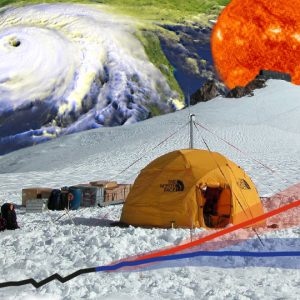Natural variations of the earth’s climate
Natural variations of the earth’s climate

The earth’s climate has changed naturally, including short and long term variations. There have been trends over millions of years as well as short-term fluctuations in the range of decades or even years (e.g. after large volcanic eruptions).
Between snowball earth and extreme greenhouse conditions
Over the past billion years we have seen extreme climatic conditions that have varied between a planet that was almost completely frozen (Snowball Earth, 600 million years ago) and an extremely warm greenhouse climate during the Cretaceous Period (the era of the dinosaurs, about 100 million years ago). It is still under discussion whether the tropics were also completely glaciated during the “Snowball Earth” period.
What is considered certain, however, is that during the Cretaceous there was no permanent ice anywhere on earth, not even at the South Pole, where ice sheets are kilometers thick today. Antarctica was an ice-free, forested continent, which, despite continental drift, was geographically in a similar position as it is today.
The dinosaurs even lived close to the Arctic Circle in the northern hemisphere and lived there under subtropical conditions.
Cooling after the Cretaceous era
The Cretaceous Period came to an end around 65 million years ago. In the last 50 million years, the earth’s climate has then started to cool down in the long term. A decisive step happened 34 to 40 million years ago: the permanent ice sheet began to build up in Antarctica and it reached a size in the order of half of the current ice sheet.
Collision of India and Asia
However, the northern hemisphere should remain largely ice-free during this 50 million year cooling. The exact reason for this cooling is controversial. One plausible theory, strongly promoted by William F. Ruddiman, assumes that the main factor lies in the collision of the two continents, India and Asia. This began around 55 million years ago and resulted in the formation of the Himalaya Mountains, the largest and highest mountain range on earth. This process continues today.
How and why mountain formation can influence changes in the climate has to do with chemical processes and greenhouse gases in the atmosphere. Read more about this in the next article.
References:
Bolius, D., 2006, Paleo climate reconstruction based on ice cores from the Andes and the Alps, Dissertation, Universität Bern
Kategorie:

Welcome to my website!
